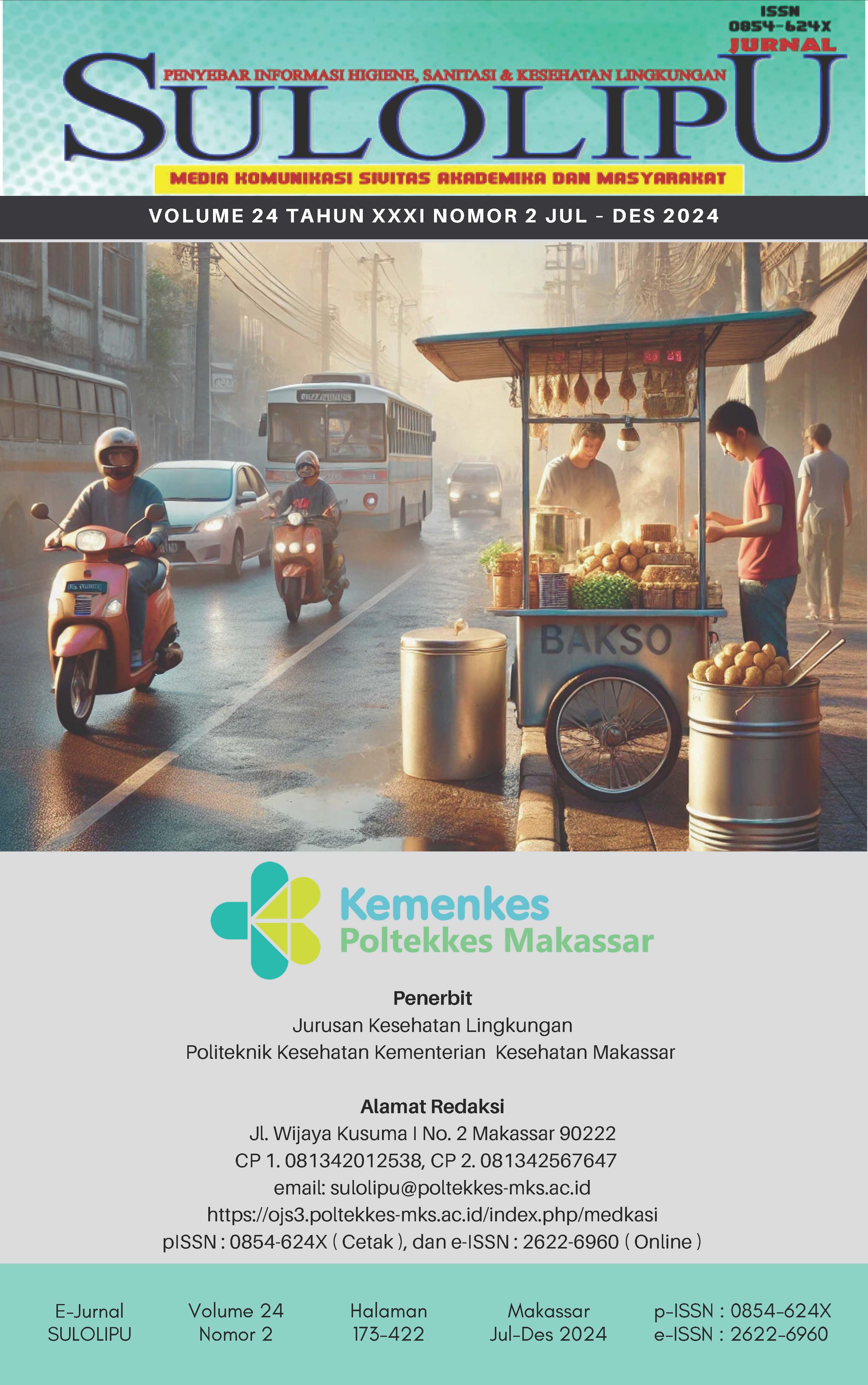Addition of Raw Rice Husk, Roasted Rice Husk, and Dried Leaves to the Physical and Chemical Quality of Compost from Buffalo Manure
DOI:
https://doi.org/10.32382/sulo.v24i2.885Abstract
The addition of materials such as raw rice husks and burnt rice husks to buffalo manure and dry leaves as compost. The incorporation of raw rice husks, burnt rice husks, and dry leaves into buffalo manure as compost. The production of compost from buffalo manure with the addition of rice husks and dry leaves can address environmental pollution caused by the organic waste of unused rice husks and dry leaves. The results of the decomposition process can also be utilized as organic fertilizer for plants. The type of research used in this study is quasi-experimental designs with three replications, employing the Kruskal-Wallis statistical test on samples of buffalo dung waste, using a comparison of raw rice husks and burned rice husks to obtain compost from buffalo dung with the best quality. The samples in this study consist of solid waste in the form of buffalo feces and organic waste in the form of raw rice husks, burned rice husks, and dry leaves obtained from Perindingan Village, Gandang Batu Sillanan District, Tana Toraja Regency. The research results on compost with the addition of raw rice husks and burned rice husks meet the quality standards of compost SNI 19-7030-2004 and show no significant differences, as compost using raw rice husks requires a decomposition time of 20 days, while compost with the addition of burned rice husks can decompose in 19 days. Both types have a crumbly and somewhat coarse texture, a soil-like smell, and are dark brown in color for compost with raw rice husks and black for compost with burned rice husks. The nitrogen (N) content is 0.53% and phosphorus (P2O5) is 0.46% in compost with raw rice husks, while the burned variety has nitrogen (N) at 0.54% and phosphorus (P2O5) at 0.94%. The conclusion of this study is that the addition of raw rice husks in the composting process is very effective because raw rice husks contain nutrients that are beneficial for plants and decompose easily.
Keywords: Compost; buffalo manure; raw rice husk; fired rice husk; dry leaves
References
Aulia, P. (2021).Karakteristik Briket Sekam Padi dengan Perekat Getah Damar dan Minyak Jelantah(Doctoral dissertation, Politeknik Negeri jember). (Online). https://sipora.polije.ac.id/7532/. Diakses pada 26 Juli 2024.
Fahira, D. (2022). Komposisi Kimia Beberapa Bahan Lignoselulosa Non Kayu (Doctoral dissertation, Universitas Sumatera Utara.
Indrawan, I. M. O., Widana, G. A. B., & Oviantari, M. V. (2016). Analisis Kadar N, P, K Dalam Pupuk Kompos Produksi Tpa Jagaraga,. Jurnal Wahana Matematika Dan Sains, 9(2), 25–31. (Online). https://ejournal.undiksha.ac.id/index.php/JPM/article/view/12650. Diakses 1 Juli 2024
M. Tosin Glio. (2016). Pupuk Organik Dan Pestisida Nabati Ala Tosin Glio (2nd ed.). Jakarta: PT Agromedia Pustaka.
Mahmud, A., & Prima, A. (2021). Inventarisasi potensi emisi metana (CH4) pada peternakan sapi perah di Kecamatan Pujon, Kabupaten Malang. Livestock and Animal Research, 19(3), 265. (Online). https://jurnal.uns.ac.id/lar/article/view/50420. Diakses pada 17 Juni 2024.
Mulyono. (2017). Membuat Mikroorganisme Lokal (MOL) dan Kompos Dari Sampah Rumah Tangga. Jakarta: PT. AgroMedia Pustaka.
Nurkhasanah, E., dkk. (2021). Pembuatan Pupuk Kompos dari Daun Kering. Jurnal Bina Desa,3(2):109-117.(Online) https://journal.unnes.ac.id/nju/index.php/jurnalbinadesa/article/view/32198. Diakses 31 Juli 2024
Imas, S., Damhuri, D., & Munir, A. (2017). Pengaruh pemberian pupuk kompos terhadap produktivitas tanaman cabai merah (Capsicum annuum L.). J Ampibi, 2(1), 57-64. (Online) https://ojs.uho.ac.id/index.php/ampibi/article/view/5058. Diakses 30 Mei 2024.
Nadipah, I. (2022). Pemberdayaan Petani dalam Pembuatan Pupuk Organik dari Kotoran Sapi dan Kerbau Gapoktan Rukun Tani Desa segobang Kec. Licin. (Online). https://sipora.polije.ac.id/15913/. Diakses pada 17 April 2023. Nurkhasanah, E., dkk. (2021). Pembuatan Pupuk Kompos dari Daun Kering. Jurnal Bina Desa, 3(2):109-117.(Online). https://journal.unnes.ac.id/nju/index.php/jurnalbinadesa/article/view/32198. Diakses pada 1 Juli 2024.
Ratriyanto, A.,dkk. (2019). Pembuatan Pupuk Organik dari Kotoran Ternak untuk Meningkatkan Produksi Pertanian. SEMAR (Jurnal Ilmu Pengetahuan, Teknologi, Dan Seni Bagi Masyarakat), 8(1), 9–13. (Online) https://jurnal.uns.ac.id/jurnal-semar/article/view/40204. Diakses 15 Juni 2024.
Rosalina, F., Sukmawati, S., & Febriadi, I. (2021). Sosialisasi Pemanfaatan Limbah Organik Sebagai Upaya Pengurangan Ketergantungan Pupuk Kimia Kepada Kelompok Tani Di Keluarah Majener. DedikasiMU : Journal of Community Service, 3(4), 1190. (Online).http://journal.umg.ac.id/index.php/dedikasimu/article/view/3258. Diakses pada 2 Juni 2024.
Romadhan, P., Gumini., Hermansah. (2023). Karakteristik Pupuk Organik Granul Biokanat Sekam Padi, Senyawa Polimer dan Tanah Liat. Jurnal Agrium,20(1), 18-25. (Online). https://ojs.unimal.ac.id/agrium/article/view/10622. Diakses pada 19 Juni 2024.
Setyaningsih, E., dkk. (2017). Kompos daun solusi kreatif pengendali limbah. Bioeksperimen: Jurnal Penelitian Biologi, 3(2), 45-51. (Online).https://journals.ums.ac.id/index.php/bioeksperimen/article/view/5181. Diakses 25 Juli 2024.
Suhana, I., Deno, O., & Chairil, E. (2017). Pengaruh Kotoran Kerbau dengan Penambahan Jerami Padi menggunakan Trichoderma sp. terhadap Karakteristik Kompos. Jurnal Agroqua., 15(2), 87–96. (Online)https://journals.unihaz.ac.id/index.php/agroqua/article/view/203. Diakses pada 19 Juli 2024.
Widiyaningrum, P. (2016). Penggunaan EM4 dan MOL limbah tomat sebagai bioaktivator pada pembuatan kompos. Life Science, 5(1), 18-24. (Online). https://jurnal.stkippgritulungagung.ac.id/index.php/jadimas/article/view/2280. Diakses pada 30 Juni 2024.
Yani, D. A., Juliansyah, H., Puteh, A., & Anwar, K.(2022).Minimalisasi Biaya Produksi Usaha Tani Melalui Pemanfaatan Limbah Buah-buahan Sebagai Pupuk Organik cair.Jurnal Malikussaleh mengabdi 1(2), 01. (Online) https://ojs.unimal.ac.id/jmm/article/view/8237. Diakses pada Juli 2024.
Downloads
Published
How to Cite
Issue
Section
PDF (Bahasa Indonesia) downloaded: 775



















